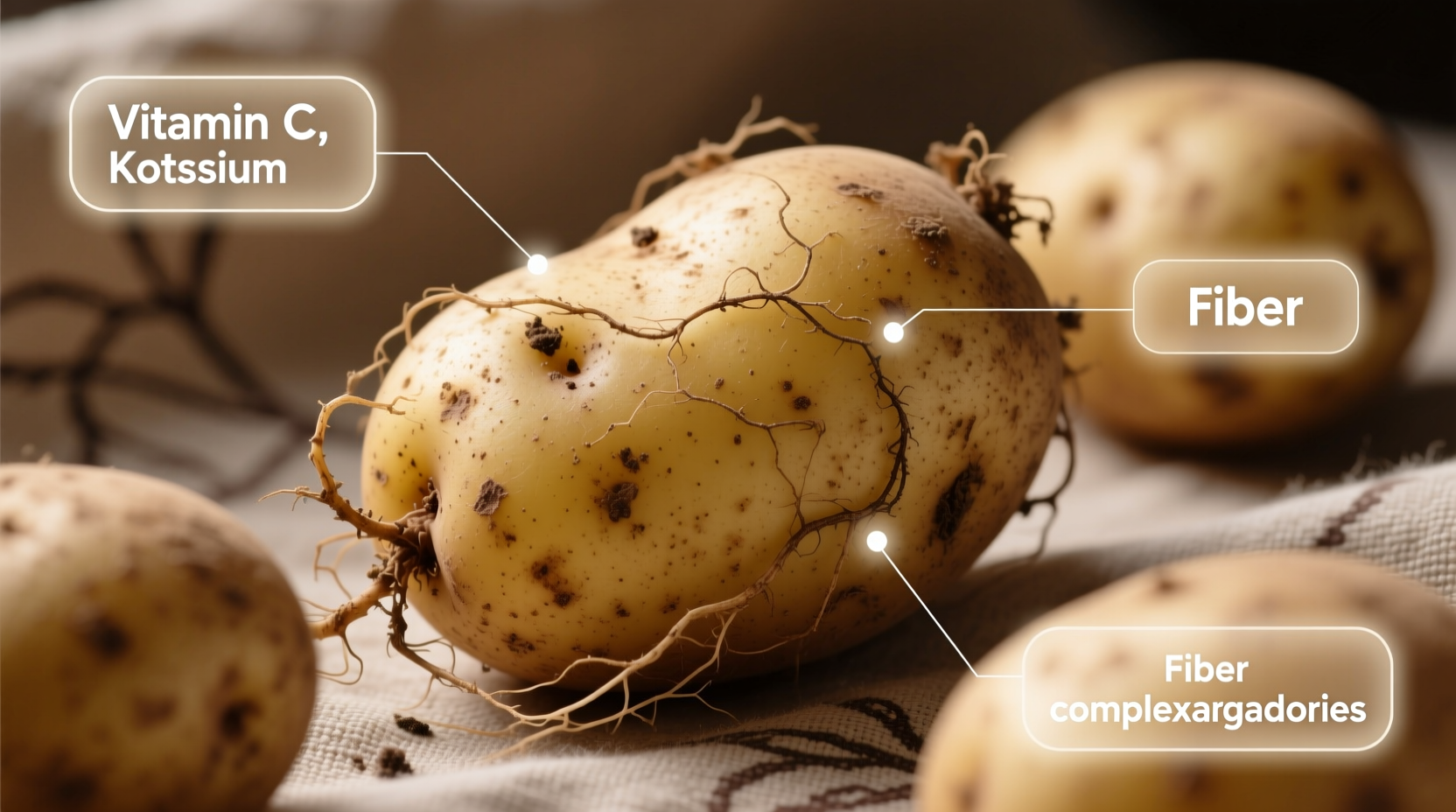Understanding exactly what's inside this humble tuber can transform how you incorporate potatoes into a balanced diet. Forget the outdated notion that potatoes are merely empty carbs—modern nutritional science reveals them as a surprisingly complete package of essential vitamins, minerals, and beneficial compounds.
Complete Nutritional Breakdown of Potatoes
A medium potato (150g) with skin provides remarkable nutritional density. The USDA FoodData Central database confirms potatoes contain significant amounts of key nutrients that many diets lack. Unlike processed foods, potatoes deliver these nutrients in their natural matrix alongside fiber that enhances absorption.
| Nutrient | Amount per Medium Potato (150g) | % Daily Value |
|---|---|---|
| Calories | 110 | 6% |
| Carbohydrates | 26g | 9% |
| Fiber | 2.5g | 10% |
| Potassium | 926mg | 26% |
| Vitamin C | 27mg | 30% |
| Vitamin B6 | 0.6mg | 35% |
| Manganese | 0.3mg | 15% |
What makes potatoes nutritionally unique is their natural electrolyte balance—particularly the high potassium content that counteracts sodium's effects. This mineral profile supports healthy blood pressure regulation, making potatoes a heart-healthy choice when prepared without excessive salt. The vitamin C content remains surprisingly stable even after cooking, unlike many other vegetables where heat destroys this nutrient.

Potato Varieties Compared: Which Offers the Best Nutrition?
Not all potatoes deliver identical nutritional benefits. Research from the Agricultural Research Service shows significant variations between common varieties:
- Russet potatoes: Highest in potassium and fiber, ideal for baking to preserve nutrients
- Yukon Gold: Contains more vitamin C and slightly higher antioxidant levels than Russets
- Red potatoes: Feature higher concentrations of quercetin, a flavonoid with anti-inflammatory properties
- Sweet potatoes: While technically a different plant family, they provide dramatically more vitamin A (beta-carotene)
The evolutionary timeline of potato cultivation reveals why these nutritional differences exist. Originally domesticated in the Andes over 8,000 years ago, potatoes developed varying nutrient profiles as they adapted to different altitudes and soil conditions across South America. When Spanish explorers brought them to Europe in the 16th century, further diversification occurred through selective breeding for local growing conditions—a process that continues today through modern agricultural science.
Cooking Methods That Preserve Maximum Nutrition
How you prepare potatoes dramatically impacts their nutritional value. Peer-reviewed research published in the Journal of Food Science demonstrates significant nutrient retention differences based on cooking technique:
- Steaming: Preserves 90% of vitamin C and water-soluble B vitamins
- Baking with skin: Maintains fiber content and prevents nutrient leaching
- Boiling: Causes 30-40% loss of water-soluble vitamins into cooking water
- Frying: Adds significant fat while reducing some beneficial compounds
Professional chefs and nutrition researchers agree that the optimal preparation method combines minimal water exposure with skin retention. Try steaming whole potatoes or baking them with a light olive oil coating to maximize nutrient availability while enhancing flavor. The skin contains nearly half the fiber and significant antioxidant compounds, so peeling dramatically reduces nutritional value.
Health Benefits Supported by Scientific Research
Contrary to outdated dietary advice, potatoes offer several evidence-based health benefits when consumed as part of a balanced diet:
- Heart health support: The potassium-magnesium ratio in potatoes helps regulate blood pressure (American Journal of Clinical Nutrition, 2020)
- Digestive benefits: Resistant starch formed when cooled potatoes aids gut microbiome diversity
- Blood sugar management: When properly prepared and paired with protein/fat, potatoes have a moderate glycemic index
- Antioxidant properties: Colored varieties contain anthocyanins and carotenoids that combat oxidative stress
It's crucial to understand context boundaries for potato consumption. While excellent for active individuals needing sustained energy, those with diabetes should monitor portions and always pair potatoes with protein and healthy fats to moderate blood sugar response. The Harvard T.H. Chan School of Public Health emphasizes that preparation method and portion size determine whether potatoes support or hinder health goals.
Practical Tips for Maximizing Potato Nutrition
Transform your potato consumption with these research-backed strategies:
- Always cook and eat potatoes with skin to retain fiber and nutrients
- Cool cooked potatoes before eating to increase resistant starch content by up to 300%
- Pair with vitamin C-rich foods like bell peppers to enhance iron absorption
- Use the potato cooking water in soups to capture leached nutrients
- Choose colored varieties (purple, red) for additional antioxidant benefits
For optimal blood sugar management, combine one medium potato with 3-4 ounces of lean protein and 2 cups of non-starchy vegetables. This balanced approach leverages potatoes' nutritional strengths while mitigating potential blood sugar spikes. The Academy of Nutrition and Dietetics confirms that moderate potato consumption (2-3 servings weekly) fits well within healthy dietary patterns for most people.











 浙公网安备
33010002000092号
浙公网安备
33010002000092号 浙B2-20120091-4
浙B2-20120091-4